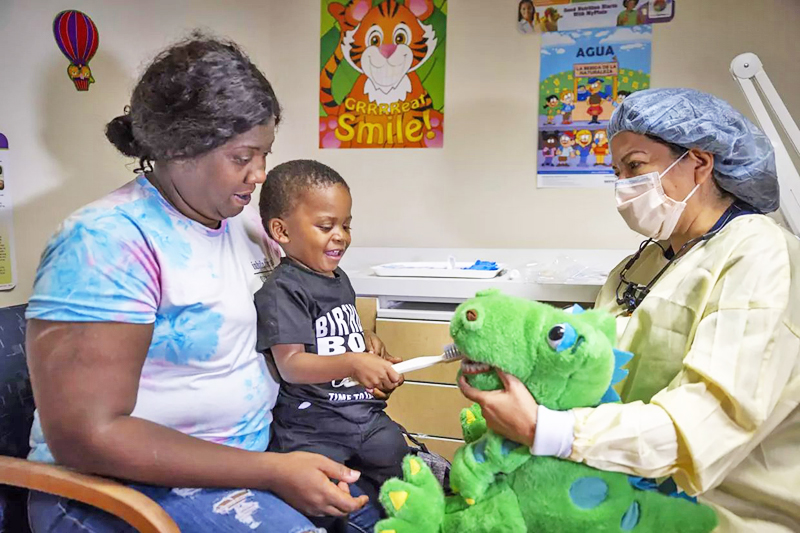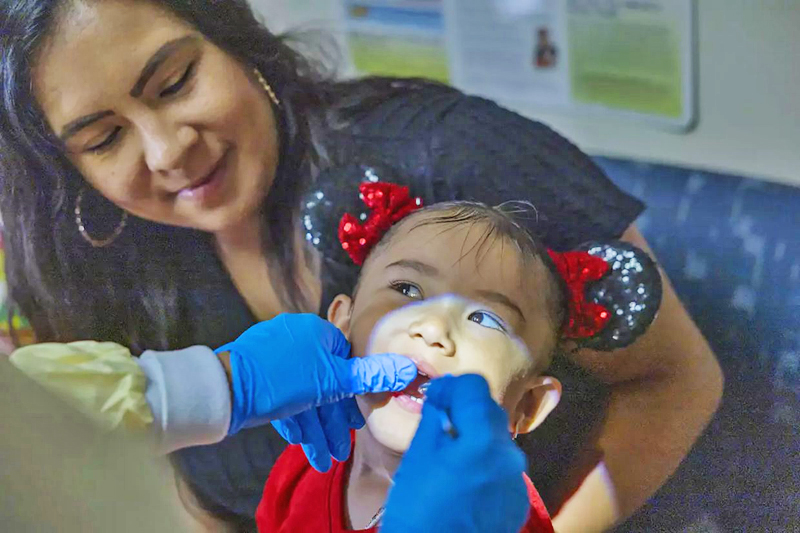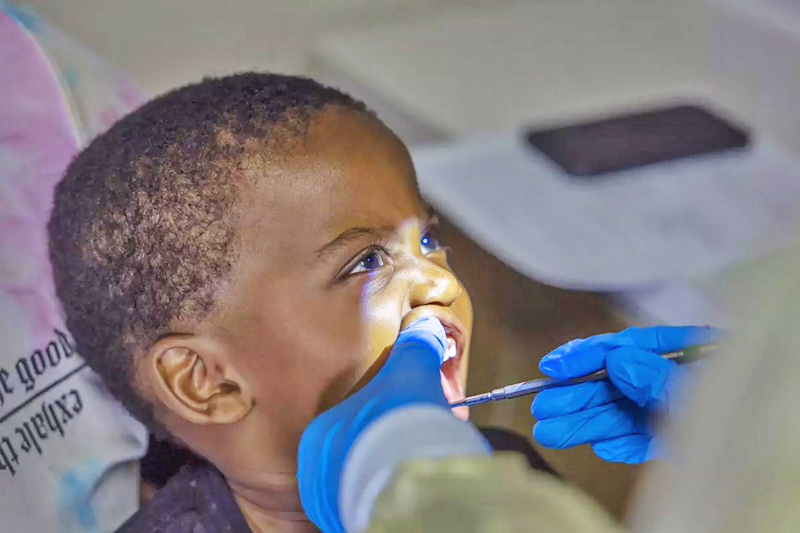CALIFORNIA – Priscilla Serrano does everything she can to keep her son’s teeth clean and healthy.
She scrubbed her son’s gums twice a day with a finger brush when he was three months old. She took him to the dentist before his first birthday.
She gives him healthy snacks, avoids juice, brushes his teeth twice a day and even flosses for him.
But despite his best efforts, Daniel still had two cavities before his sixth birthday.
“I feel a bit empty. You work so hard to prevent all of this, and then you see your child in pain,” said Serrano of Long Beach.



“I denied at first. I was like, ‘No, I’m doing a good job.’ But I finally accepted.”
California ranks worst among states when it comes to pediatric dental disease.
A national survey from 2020-21 found that 14.8 percent of children in the state ages one to 17 had tooth decay or cavities in the past 12 months surveyed – ranking 47th out of 51 among all states and the District of Columbia.
“We really emphasize prevention because we don’t want to deal with cavity problems, oral pain, possible infection, or the spread of infection,” said Dr. Abrey Daniel, a dentist in the Oral Health Program at the Los Angeles County Department of Public Health.
“Sometimes parents may just brush too quickly without realizing that a cavity is forming.”
Nationally, more than half of children develop cavities by the age of eight, usually due to poor nutrition, poor hygiene habits or lack of dental care.
Other factors include drinking water without fluoride, insufficient saliva flow, and genetics. Even children with good dental habits can develop cavities.
As with many other health problems, children from socioeconomically disadvantaged families are most at risk.
The California Department of Public Health’s 2018-19 Smile Survey of third graders found that children from communities of color and Spanish-speaking families were more likely to have tooth decay.
Latino children had the highest rates, with 72 percent experiencing some form of tooth decay, compared to 40 percent of white children.
Black children have the highest rate of untreated tooth decay at 26 percent – nearly double the rate of white children.
Across the state, many low-income children have limited access to dental care, fresh fruits and vegetables, and fluoridated tap water, said Dr. Ryan Huang, director of dentistry at South Central Family Health Center.
Less than 60 percent of the population across California receives fluoridated water, according to the CDC.
Brushing your teeth twice a day with fluoride toothpaste is also important, but many children in California don’t meet that requirement, Huang said.
Some families cannot afford toothpaste or toothbrushes, and others do not know the basics of dental hygiene.
“There is a lack of proper education not only with children, but also with parents,” said Huang.
NO ACCESS TO DENTAL CARE
The state has in recent years worked to improve its dental insurance program for the underprivileged — which was harshly criticized in 2016 by the Little Hoover Commission for failing to provide adequate care to half of the state’s children.
According to the commission’s report, few dentists in California accept such insurance, due to low reimbursement rates and complicated bureaucracy, leaving many low-income California children without access to dental care.
Only about half of eligible children receive dental care each year because so few dentists are willing to treat them, compared to two-thirds of children with commercial insurance, according to the commission’s findings.
Since then, the state has increased payment rates for dentists in an effort to improve access for patients.
A 2022 state survey of MediCal dental providers found that 54 percent said the average wait time for a non-urgent appointment was less than a week; 40 percent said that the wait time was between one and three weeks.
The 2018-19 Smile Survey found that the rate of tooth decay had decreased in the previous decade, but was still well above national data. In California, 61 percent of third-year students have had tooth decay, compared to a national median of 53 percent among other states.
Dentists say that the rate of decay is likely to worsen during the pandemic, when many children do not attend dental appointments.
State law requires parents of kindergarten students to submit proof of an oral health evaluation, but this mandate is not enforced.
Parents are allowed to fill out a waiver explaining that they did not complete the evaluation for a variety of reasons, including the inability to find a dental provider, said Eileen Espejo, who leads the oral health project at Children Now.
There are efforts to screen and treat students who don’t have access to care through dental clinics in schools, including in LA Unified, with help from local nonprofits and county health departments. However, the available resources do not come close to the students’ needs.
THE IMPORTANCE OF HEALTHY CHILDREN’S TEETH
Dentists say that waiting until a child reaches school age to start regular dental checkups is too late.
“Many parents have the misconception that baby teeth will fall out and are not important, but baby teeth are the best indicator of oral health for adults,” said Dr. Daniel.
Children’s teeth are very important for speech development, proper nutrition, and jaw formation. Dental problems can cause long-term complications for a child’s overall health and well-being.
Cavities in baby teeth can spread to permanent teeth that are waiting to grow. And severe, untreated damage can lead to broken teeth, abscesses and in extreme cases, even death.
Also, because baby teeth have a thinner outer layer of enamel, which allows bacteria to damage the teeth more quickly, they are more susceptible to cavities than the permanent teeth they replace.
Cavities can form earlier. In extreme cases, baby teeth may grow in children who already have cavities.
Careful care for baby teeth and first permanent teeth rests entirely in the hands of parents and caregivers, and their early practices will have a long-term impact on a child’s future dental health.
A LONG LIST OF DOS AND DON’TS
Recommendations for children’s dental hygiene go beyond brushing twice a day and avoiding lollipops. Some recommendations are well known: Brush your teeth twice a day.
Avoid sticky sweets that are difficult to remove from teeth, as well as sugary juices and sodas. Do not let your child fall asleep with a bottle of milk. Visit the dentist as soon as the child is one year old, and make sure the child receives fluoride treatment.
Other recommendations are also important, but less well known and somewhat complicated. From the moment a child is born, for example, dentists advise that caregivers start wiping their gums with a clean cloth after feeding.
Some dentists advise wiping even after midnight feedings, while others think twice a day is enough.
“If the children are sleeping, the last thing I will do is put my finger in their mouth,” said Dr. Lisa Berens, a professor at the UC San Francisco School of Dentistry.
“It’s more to get them used to the taste of something in their mouth.”
Brushing teeth should be done as early and as often as possible. When the first teeth appear, dentists recommend starting to rub a small amount of fluoride toothpaste on your child’s toothbrush twice a day – just enough to color the bristles – and avoid using ‘training toothpaste’ that does not contain fluoride.
“Training toothpaste is useless because it gives parents a false sense of security. It doesn’t work,” said Ramos-Gomez.
Meanwhile, caregivers should start flossing either when the child has two adjacent teeth touching or by age five, and continue brushing their child’s teeth until age eight.
“Even if the child doesn’t want to, you have to do it,” said Ramos-Gomez.
Nutrition is also important. Children should minimize snacking to three times a day or less and try to avoid not only sweets but all sticky foods, including dried fruits such as raisins and gummy vitamins, which tend to stick to teeth and are difficult to wash off.
For drinking, dentists remind caregivers to give children fluoridated tap water rather than bottled water, to help prevent decay.
And avoid sharing saliva with children or even blowing on their food.
Bacteria that cause cavities can spread from an adult’s mouth. – Agency

